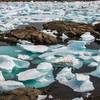clear
Why is Arctic ice crucial to climate change?
clear

source:
Taken / Pixabay
As well as reflecting the sun, the ocean, Arctic and its ice has several uses in terms of climate change. If Arctic ice melts, it may disrupt the 'heat engine' that is our ocean. The temperature of the ocean largely contributes to the world's weather. If there is less sea ice, it will alter how cold the sea is and, consequently, atmospheric and ocean circulation which, in turn, could cause changes in air pressure and lead to more extreme types of weather such as vigorous storms and even hurricanes. The sea ice also helps to keep the Arctic cold, so if it was to disappear due to global warming, the Arctic's environment would rapidly become warmer. Of course, the melting of ice also increases the likelihood of flooding which, over time, could see low-land areas, especially small archipegelos, destroyed and lost to the ocean. If climate change continues at the same rate it is currently, it's likely that the world could be a very different place in just hundreds of years, as opposed to the thousands those that do not believe in the changes, or the speed of the change, think.
 0
0
clear
Answer: Arctic ice may help to lead climate change or it may follow climate change.
It may help to lead climate change because of its albedo – how much radiation is reflected from its surface. Its extent will also shield the sun’s heat from the ocean to a greater or lesser extent. If the extent is small then the albedo will be small and more heat will be absorbed by the ocean. If the extent is large then the opposite is true.
However, it may be the case that Arctic ice has little direct impact on climate change, and may instead react to climate change.
Nobody knows.
One thing for sure is that the predictions that the Arctic would be
have so far not materialised. And in any case the Arctic has been navigable as recently as the 19th century.
Greenland ice is interesting. The ice there is melting… and what is under the receding ice? Farms. This backs up evidence that Vikings had farms in Greenland during the mediaeval warm period (MWP) (around 950AD). So Greenland was cold, it warmed enough for farming, then got cold again (all without SUVs) and is now getting warm again.
Nobody knows what caused the MWP nor what made it end and become cold.
The website skepticalscience.com is in fact a site that supports the theory of man-made climate change. Here is that site’s attempt to explain why the climate changes in Greenland were caused by natural forces, but that current changes are not. Note how many “coulds” “probablys” and “reconstructions” and other vague terms exist therein. https://www.skepticalscience.com/greenland-used-to-be-green.htm
 0
0
clear

Sign up to post or vote on answers.
Improveo will help systemize your knowledge.